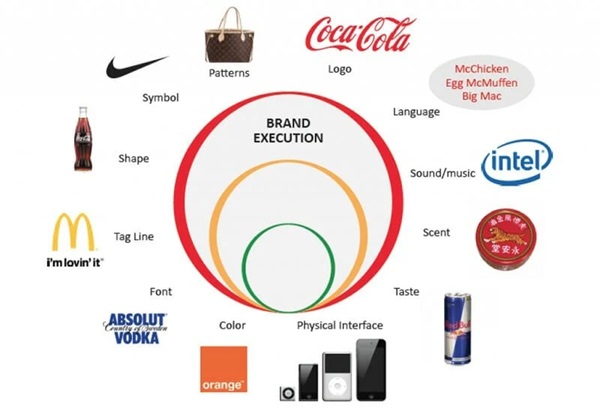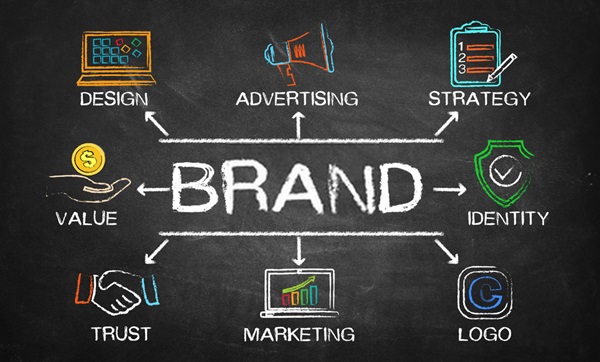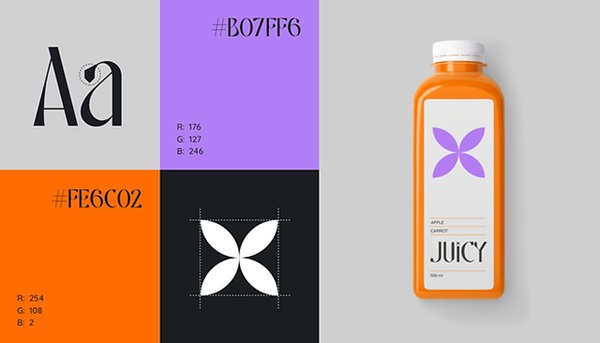What is Brand Identity? How to Create a Unique Brand Identity and Its Impact on Branding + Example
What is brand identity? In this article, we will define brand identity, its importance, and methods to create a unique brand identity.
Brand identity (Brand Identity) is a very important topic in branding. Just as your personal identity makes you unique, brand identity distinguishes your company among others.
However, creating a brand identity is more than just designing a logo. Brand identity means the entirety of a brand. Identifying in branding is what occupies the minds of most business owners, trying in some way to have a unique identity in the market.
Now, what exactly is brand identity? How can you design a strong and impactful brand identity? In this article, we will address these and other questions that might have occupied your mind.
What is Brand Identity?
Brand identity is what you say and believe in. Things like your values, how you communicate with your products, and what you want people to feel when they interact with your products/services are part of the brand identity. Your brand identity represents the personality of your business and expresses your responsiveness to the audience’s needs.
As Jeff Bezos, the founder of Amazon, says:
Your brand is what people say about you when you’re not in the room.
This identity refers to features that identify and distinguish the brand in the consumer’s mind, such as color, design, and logo. Brand identity makes it easier for customers to know you better. Brand identity determines the type of customer attitude towards the brand.
Difference between Brand Identity and Brand Image
You might wonder what the difference is between brand identity and brand image? Brand identity is the entirety of all brand components created by the company with the aim of presenting a suitable image of the company to the customer. However, the brand image represents the perception that forms in the consumer’s mind about the product or brand.
While brand identity is actively created by the company, brand image is shaped by the actual experience of the consumer.
Designing Brand Identity: How to Create a Unique Brand Identity?
Here, as in other stages of starting a business, you must first have a good understanding of the market, audience, and competitors. One of the most important things to consider when designing a brand is how pleasing your brand message is to your target audience. So try to find the pain points and needs of the audience and show them how your company solves that problem.
But before you start designing, first identify and establish the design elements of the brand. The basics you need to know about are:
1.Typography
Typography is the font you choose for your brand design. Your font affects the audience’s perception. Let’s examine the four typographies in the above picture (which are the most common examples):
Fonts like the image number 1 (e.g., Times New Roman or Garamond) have an end for each letter resembling an anchor (or small feet). If you want your brand to appear trustworthy and somewhat old, this classic typography is a great choice.
These models of fonts (e.g., Helvetica or Franklin Gothic) include letters with smooth edges and unlike fonts number 1, lack an anchor at the end. Sans serif fonts give a chicer and more modern feel to the brand.
Script and calligraphy fonts are a great way to convey a sense of luxury or femininity to the brand.
Display fonts (like the Metallica font) are unique in their own right. Each display font has a special feature. Brands use these types of fonts when they want to make a bold statement and create an unforgettable brand identity.
Remember, typography says a lot about your brand. So choose your font wisely.
2.Color Palette
The second principle is color. Based on the psychology of colors, people form psychological connections with different colors. Strategic use of color in branding and logos plays a significant role in how the brand is perceived by audiences. Here we explore some colors that can help build the correct brand identity.
Designing Brand Identity Based on Color Psychology
Red
Red is the color of passion and excitement. If your brand identity is loud, youthful, and exciting, this is a great choice.
Orange
Orange is another high-energy color, and if you want to appear friendly and playful, it’s a great choice. This color is used less than red and using it can distinguish you.
Yellow
The color yellow is the color of the sun and ultimately the color of happiness. Its cheerful vibe makes it a good choice.
Green
A versatile color! Green can almost be used for any brand. But culturally when people see this color, they think of two things: money and nature. If your brand is tied to one of these things, green is a good choice.
Blue
Blue is one of the most attractive colors that creates a more stable and trustworthy brand identity. So if you’re looking to attract a lot of people and build trust with customers, choose blue.
Purple
Purple is the color of royalty. Use this color to convey a sense of luxury.
Pink
Right or wrong, pink is culturally tied to femininity. So if your brand’s target is women, pink is a suitable choice. It’s also a great color for brands with a gentle or luxury identity.
Brown
Brown might be the least used color in branding, but this can make you stand out. Brown also makes the brand appear masculine.
Black
If you want to appear modern and mysterious, nothing is as effective as black and white.
3.Form/Shape
When designing, you should also pay attention to form and shape. This subtle yet effective feature can be used to improve the desired customer response: for example, a logo that is entirely circular with soft edges creates a very different feeling than a sharp and square logo.
Next, we examine the impact of different shapes on brand identity:
Round shapes (like circles and ovals with soft edges) create feelings of love and trust.
Shapes with straight edges (like square, rectangle, and triangle) convey a sense of power and efficiency. You should be careful to use dynamic and balanced colors for these shapes otherwise the customer may not connect with them.
Straight and vertical lines indicate power and stability while horizontal lines represent calmness and mild conditions.
Elements of Brand Identity
After you have defined the components of the design, it’s time to work with a designer and bring your brand identity to life. Many elements play a role in creating and introducing brand identity. Elements of brand identity include:
1.Logo: The Face of the Brand
The first thing that attracts the audience’s attention is your brand’s “logo.” Thus, the logo should be designed in a way that represents the face of your brand and creates a positive impact in the mind of the audience. Also, a logo introduces your identity and brand, sending the message to the audience that [this image] means [this company].
Characteristics of a suitable logo:
- Clearly states who you are and what makes you different.
- Visually appealing.
- Classic, not trendy, and timeless. You definitely don’t want the company logo to go out of style after 6 months!
- Aligns with the company’s standards.
- Leaves a lasting impact on the audience.
2.Website
The website is one of the most important elements of brand identity that plays a significant role in introducing it to the audience. Especially if you have an online business or a digital product, customers will definitely check the website before purchasing. The website is where the brand identity is fully revealed.
3.Business Card
If you are developing your business, do not forget the business card. A well-designed business card captures the potential customer’s attention at first glance and has no less impact than the logo. The simpler the business card, the better. You can write the logo on one side of the card and key information on the other.
4.Product Packaging
Product packaging is also part of the brand identity. How your goods are packaged plays an important role in the customer’s attitude towards the brand. Also, suitable and attractive packaging attracts customers and increases repeat purchases.
5.Company Mission Statement
When you create an identity for your brand, you bring it to the attention of your audience and give it credibility. Doing this commits you to target-setting and planning in a specific direction.
All successful companies have a mission statement that precisely specifies their goals. A mission statement is a short statement that explains the company’s goals (in terms of product and service offerings, customer interaction, target market, etc.).
Methods for Creating an Effective and Memorable Brand Identity
1.Research the needs of the audience, value propositions, and the performance of competitors.
The first step in creating a brand identity is to complete market research. At the beginning of the journey, specify the following:
Audiences
Different people have different needs. You cannot offer a product suitable for a teenager to university students. Therefore, understanding the needs and expectations of the target customer is very important in creating a popular and universally accepted identity.
Value Proposition and Competition
What makes your company unique in your business market? What advantages can you offer to consumers that others cannot? Knowing the differences and advantages you have over other competitors is essential for brand development. Reviewing the performance of competitors can also help identify practical branding techniques.
Goals and Mission
Always fully describe your mission statements, visions, and goals. The more you know about your business goals, the stronger your brand will be.
Brand Personality
When creating a brand image, look for an appropriate personality. Use colors and other visual elements to convey brand identity. Creating a brand identity requires thorough and extensive research.
SWOT Analysis
Using the SWOT analysis tool can be useful for better understanding brand identity.
2.Design an Attractive Logo and Pattern.
We mentioned that the logo alone does not constitute your brand identity, but it is a vital element for consolidating the brand. Because your logo is everywhere (from your website to your business card and online product advertisements). So it can be said that the logo is the most recognized part of the brand.
As we previously stated, brand design (typography, color, shapes) conveys different messages to the audience. So definitely design the logo correctly and appropriately for your brand personality.
For example, consider the McDonald’s logo. The golden arches are a kind of typography for the symbol “M”. The color of this logo and its symmetry convey many concepts.
Review of McDonald’s Brand Identity
You should also create specific templates for your emails, customer thank-you letters, or business cards to have a credible and professional appearance.
Finally, write a branding strategy document and record everything in it. And remember, in a society that is always looking for the best and most up-to-date things, flexibility is as important as stability. Flexibility adjusts the overall identity of your brand in advertising campaigns, labels, etc. Only in this way can you continuously meet the needs of your audience and maintain their interest in your business. But remember to make a change across the entire brand, not just in one aspect.
3.Use a Unified Language for Communicating with Customers, Advertising, and Interaction on Social Networks.
When you have established your brand and completed all the necessary steps for developing brand identity, it’s time to strive for its expansion and dissemination. One of the most successful methods is offering impactful content. The content you produce represents your brand, marketer, and salesperson. Therefore, every single word of the content must reflect your brand.
Great content creates a great brand and boring content creates a boring brand!
Use language that aligns with the brand’s personality. That is, if you are a reputable brand, use professional language, and if you are still at the beginning, use a friendly tone to attract customers. Your language and tone affect all branding activities.
Communications and Emotions
People love stories that are emotional and moving. Therefore, a strong brand identity helps establish an emotional connection with consumers, allowing you to create a deep and lasting relationship with your audience.
Advertising
Advertisements, whether traditional or digital, are the most effective way to introduce your brand to the world. So, you can use this method to make your brand message seen and heard and attract more customers.
Social Networks
Another effective way to communicate with consumers is through social networks. There are countless platforms you can use to strengthen brand identity. You can also directly communicate with your customers and audience through social networks and interest them in your brand. Always respond to customers’ comments on social networks (especially if there is a question or complaint); this way, you will increase your popularity and likability among the audience.
4.Know What to Avoid
Avoid the following actions to prevent creating instability or failure in your brand identity:
Sending Unclear Messages
Before sending any message, first, fully specify your goal. Use appropriate language and images. Keep in mind that if something is clear and transparent to you, it does not mean it is clear and transparent to your customers. So, as much as possible, simplify and summarize your messages.
Imitating Competitors
Never imitate your successful competitors. This act detracts from your brand value and damages your credibility. Of course, you can review their effective activities and integrate them with your ideas and creativity. This way, you achieve success while maintaining your unique features.
Changing Style
Use consistent colors, fonts, themes, and messages (both in print and digital)
5.To Maintain Your Brand Identity, Review and Analyze Your Performance
It’s clear that without tracking your key performance metrics, you cannot identify the positive and negative effects of your activities and correct your mistakes. For this purpose, you can use programs like Google Analytics or through surveys and review of comments to measure and monitor your brand’s performance and interaction with customers. This way, if necessary, you can make changes to your branding strategies.
Examples of Brand Identity from Famous Companies
A brand is much more efficient, important, and beyond a logo or trademark. Next, we will examine this topic in more detail:
Coca-Cola
When you hear the name Coca-Cola, you probably remember its famous logo. You may also think of the polar bear, the red color, the “Share a Coke” campaign, or the classic images on its cans.
Red-colored logo with the company name engraved on it: The color red strengthens the feeling of confidence in people. Also, the type of writing on the bottle evokes a sense of pleasure in the person. For example, coffee is a beverage you consume in the morning before starting work, and Coca-Cola is a beverage that, when consumed in the afternoon, relieves fatigue and brings a sense of joy and pleasure. What we said only applies to
the “face” of the brand.
Unique Logo Shape: No other beverage bottle looks like the bottles of this company. In fact, Coca-Cola tells its audience that it does not need to imitate and model other companies and is self-reliant. It also increases the credibility of its brand among its audience with its unique creativity.
POP Fit
The beautiful logo of this brand is created with bright pink and purple colors. This company introduces its brand identity with a specific message and idea. According to the POP Fit Clothing website, the products of this company are based on the idea of positivity in fashion and media.
POP Fit Brand Identity Highlights
This company shows its brand message and identity in its advertisements and uses women of color, people with disabilities, and different body sizes, avoiding presenting unrealistic images. The images presented in this company’s advertisements are unretouched, realistic, and respectful.
The products of this company solve the problems of the sports clothing industry (such as limited sizing, lack of pockets, dark colors, etc.).
Asana
Asana is a management software that allows members of an organization to collaborate with each other to advance their goals. The Asana logo is made up of three orange and pink circles placed next to the company’s brand.
The founder of this program started his work at Facebook; a company that needed a project management and internal collaboration tool. Asana’s slogan is “Helping humanity thrive by enabling the world’s teams to work together effortlessly.”
Asana, in Sanskrit, refers to a specific gesture that yogis use to focus. Therefore, it can be said that the brand identity of this company was formed in line with paying respect to the principles of focus and Buddhist flow. This is clearly evident in the company’s commercial logo and its values (finish big jobs faster).
Asana Brand Identity Highlights
Asana uses a lot of white space to focus and inject energy into the work environment.
The three points in the logo that are arranged together represent the balance and collaboration among team members.
McDonald’s
McDonald’s is an American fast-food chain company, known for its hamburgers, fries, and, of course, its golden arches symbol. Without a doubt, McDonald’s is one of the most recognized brands worldwide. Simplicity is the key to the brand identity of this company. Its simple design pattern with red and yellow colors represents warmth, intimacy, and accessibility of McDonald’s.
Every aspect of McDonald’s brand identity, from its logo and packaging to its brand message, is focused on the target audience and customer.
Wherever in the world you go to McDonald’s stores, you will experience this brand in the same way. The visual identity of this brand and its integrated products have made McDonald’s a trustworthy brand for everyone. Wherever it opens a branch, it immediately uses marketing strategies according to that region and aligns itself with the culture of the people of that area.
Conclusion
Building a memorable brand requires creating a brand identity and using a unique format, color, images, and language. When consumers quickly remember your brand by seeing a specific color or design, you will be assured that you have achieved more credibility than just a name and symbol and have established your brand identity in the audience’s mind.
Elevate your brand’s presence and connect deeply with your audience by embracing the innovative branding services of Imazh Studio – where your brand’s identity comes to life.





























